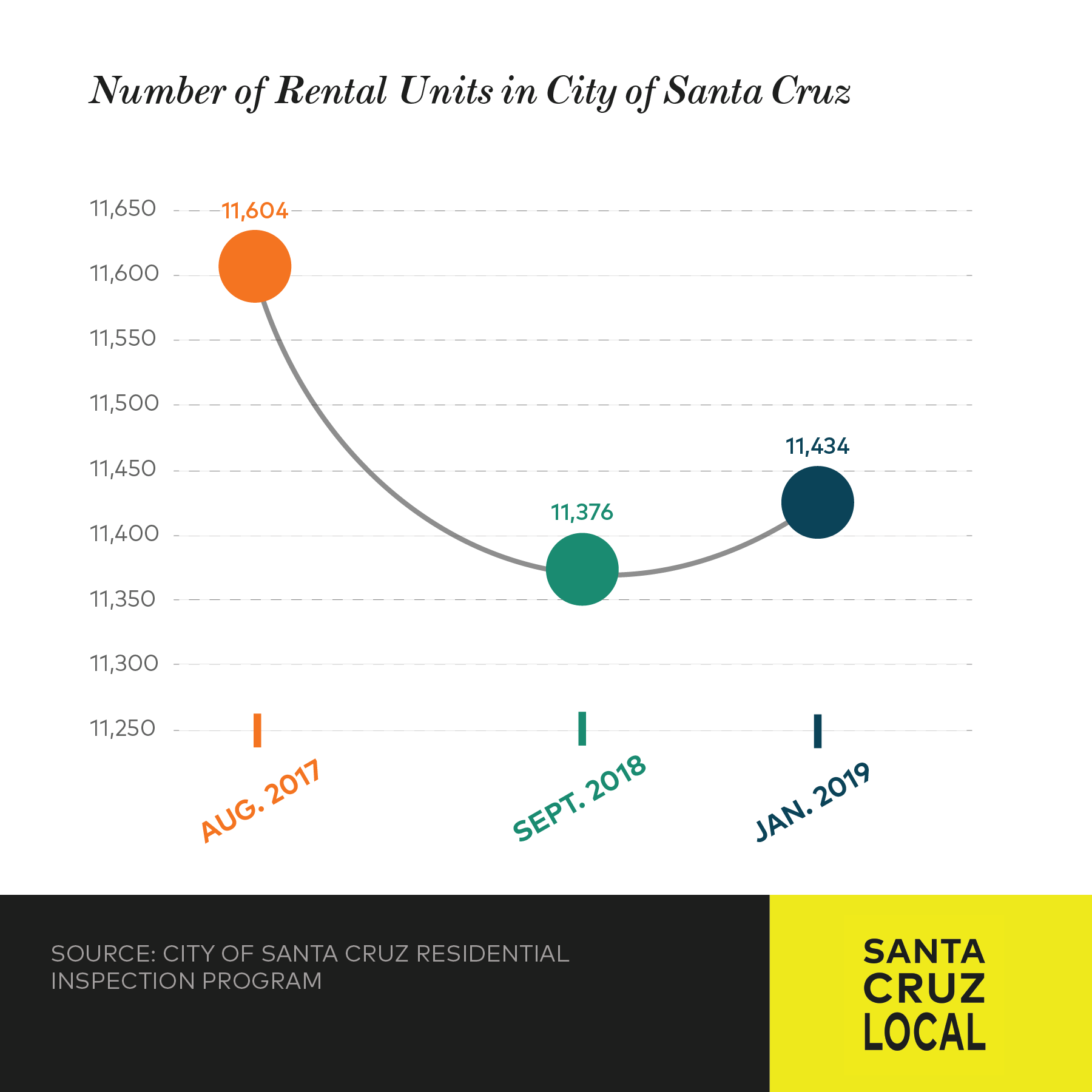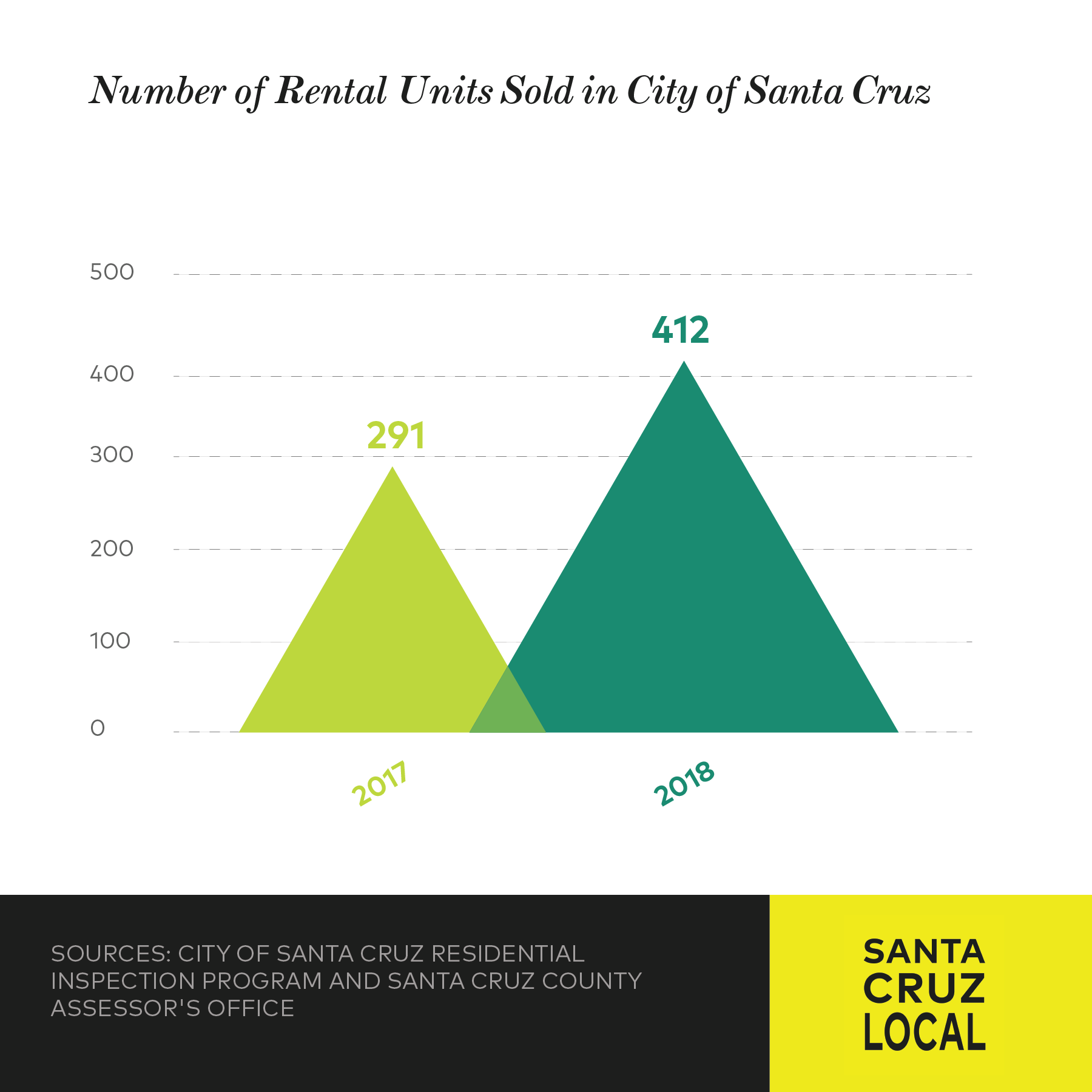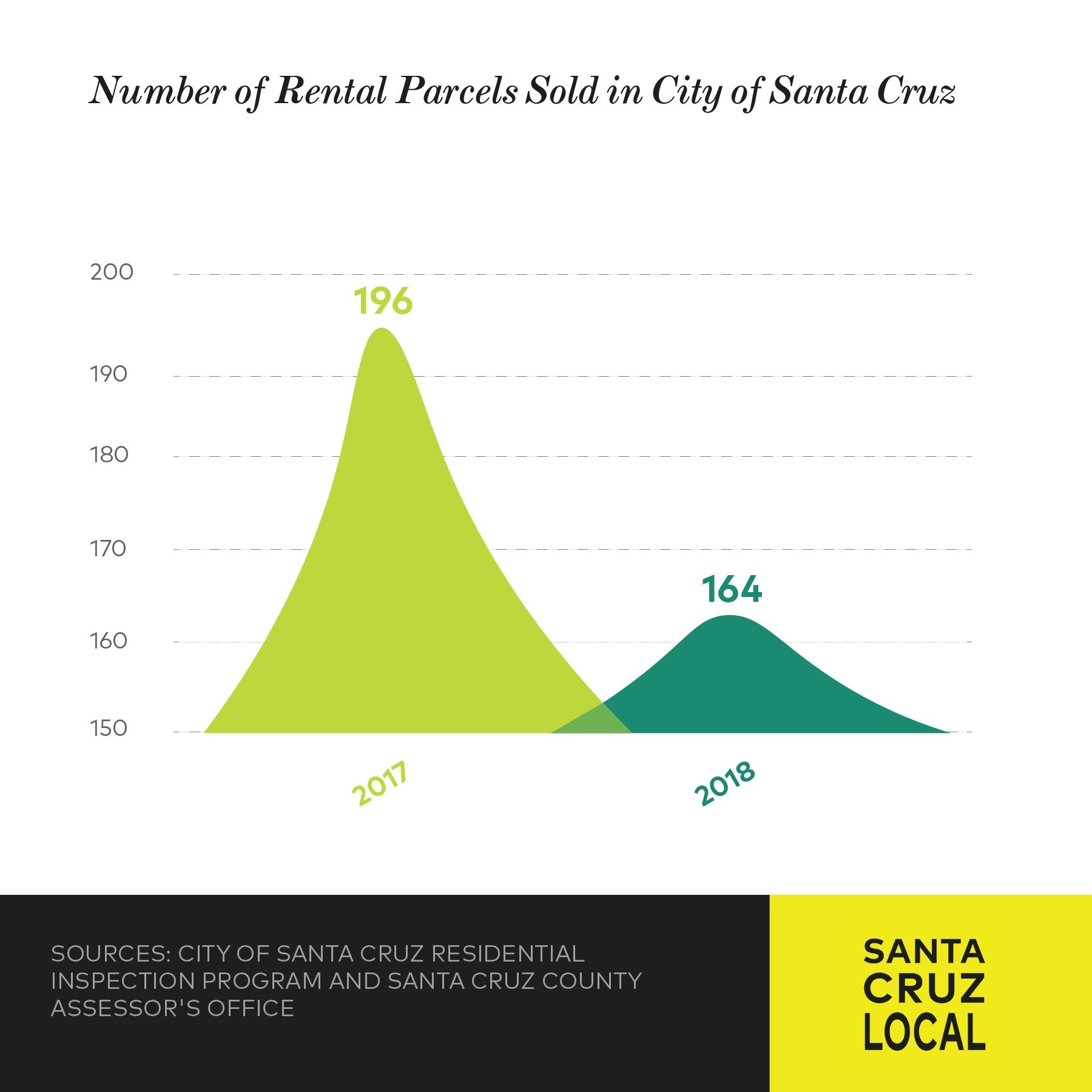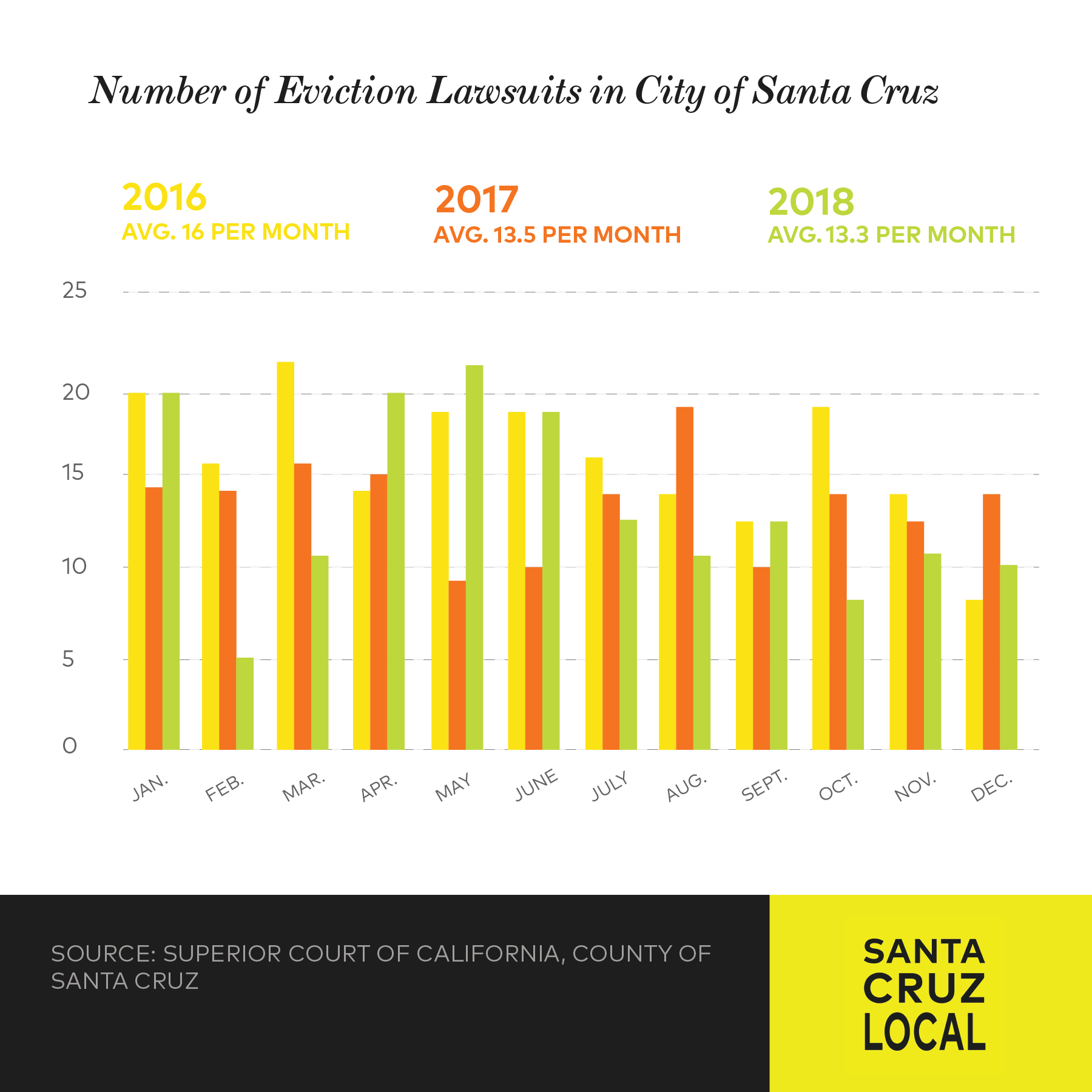City, county data show need for better monitoring of rental housing stock
Since the start of the Measure M campaign in 2018, one thing has been missing from Santa Cruz’s debate on rent control and eviction rules: data from neutral sources that detail the city’s rental market.
Measure M, which would have started rent control restrictions for some landlords in the city of Santa Cruz, failed at the ballot box in November. But the community remains divided as the city enters a year of formal talks on a Plan B for tenant protections. A task force of landlords, renters and activists is being formed — but few real numbers are available to help guide their decisions.
Santa Cruz Local wanted to change that.
Santa Cruz Local reporting culled data from four sources: the city’s Residential Rental Inspection Program, the Santa Cruz County Assessor’s Office, the real estate agent database MLS, and Santa Cruz County Superior Court.
The reporting had several goals:
- to find out how many rentals the city has and to track trends over the last few years
- to fact check some real estate agents’ claims that rentals have been lost from the market due to the Measure M campaign
- to find trends in the number of evictions in the city
Maps produced by city staff for this report showed how the rental market has shifted geographically in the past few years. While the data suggested that the city had fewer rentals in 2018 compared to prior years, the investigation was not conclusive. None of the four sources were designed to track data and trends, so there were several holes in the process.
Instead, what the Santa Cruz Local investigation uncovered was a need for a dedicated rental database and tracking method. This data — including rent prices, number of tenants, tenant turnover and other information — could be collected by adding a few questions to the city’s rental inspection forms that landlords already complete. If the city wants to base future rental policy decisions on real numbers, a comprehensive method for tracking rental data is needed.
To hear more about our search for data, listen to the Santa Cruz Local podcast, epsiode 10: “Show me the data”
HOW MANY RENTALS?
To see how the city’s rental stock is changing, Santa Cruz Local submitted a public records request to the city’s Residential Rental Inspection Program for lists of registered rentals at various points in time.
Unfortunately, the city does not keep an active inventory of registered rentals. Instead, the city has lists of registered rentals plus units that may or may not be rentals. The rental inspection program keeps this list to track units that may need inspection. Also, the city only updates its list sporadically. It does not keep old copies of this list. The oldest version of the list that Santa Cruz Local could obtain was from August 2017.
Santa Cruz Local got help from City of Santa Cruz GIS Manager Richard Westfall, who produced several maps specifically for this story.
The first map compares the city’s rental inspection list in August 2017 with the same list from January 2019.
RentalProgramParcelChanges2017_2019cAt first glance, the map seems to show an overall loss of 170 rental units between August 2018 and January 2019.

The addition of another data point, from September 2018, seems to show that the number of registered rental units in the city dropped in 2018, but has since climbed back up slightly.
Why does this matter?
During the 2018 election season, Measure M opponents — many of whom were realtors or landlords — asserted that rent control and eviction rules would reduce the city’s rental housing stock, as it did in San Francisco and Santa Monica.
These Measure M opponents said that even the talk of new laws has already spooked landlords and prompted them to sell their properties in fear that their investments may not pay off.
It is unclear whether the city rental inspection program data backs up Measure M opponents’ claims. Though the data suggests a drop in rentals during the heat of the 2018 campaign, it is unclear whether drop is due to normal year-to-year variance or other factors.
HOW MANY RENTALS SOLD?
Santa Cruz Local also submitted a public records request to the county assessor’s office, for a list of all the sales in the county in 2016, 2017 and 2018. Thanks to the work of Rich Westfall, Santa Cruz Local was able to combine sales data with city rental maps, to see which rental units sold in 2017 (pre-Measure M) and in 2018 (after the introduction of Measure M).

The data showed more sales of possible rental units in 2018 compared to the previous year.
However, rental units are different from rental parcels. For example, an apartment complex might be on a single parcel, but have four rental units.

Looking at the number of rental parcels sold would give a clearer picture of how many owners decided sell. The data showed fewer possible rental parcels sold in 2018 compared to the previous year. Around 160 possible rental parcels were sold in 2018, compared to around 200 the previous year.
To be clear, this statistic only shows turnover: It does not show whether the rental stock is shrinking. A rental unit or parcel may still be rented by the new owner.
MORE SHORTCOMINGS
The city’s rental inspection list is incomplete. It does not include in-law units in which the owner lives on the property, for example.
Furthermore, the city’s rental inspection list includes errors. For instance, the 2017 list incorrectly includes the De Anza Mobile Home Park on Delaware Avenue. Those units are owned, not rented. That accounts for around 200 units. When the city fixed the error in the 2019 list, it seems as if those 200 units were lost from the rental stock. But really they didn’t exist because they weren’t rentals.
Also, the 2018 data on sales of rental properties were skewed by the sale of the Outlook Apartments on Western Drive. That sale alone accounted for 168 units — if that sale never happened, then 2018 would have had fewer sales of rental units than the previous year.
Lastly, the sales data from the county only goes through November 2018 due to a lag between the sale of a property and a county assessor’s office record.
WHAT ABOUT MLS DATA?
The Multiple Listing Service database, or MLS.com, is an independently-owned national website that lists properties that are for sale, as well as the sale history for each address.
MLS.com has two types of access: a free, public view and a paid, premium view for real estate professionals. Santa Cruz Local obtained the paid, premium access and compiled a list of all the rentals that sold in 2018.
However, the problem was that the numbers were faulty and incomplete. The database is written by real estate agents. Some fields are accurate, such as the sale price, but others might not be accurate. Santa Cruz Local found that MLS.com’s data on whether a property is a rental was not accurate.
HOW MANY EVICTIONS?
Santa Cruz Local submitted a public records request to the Superior Court of California, County of Santa Cruz, for numbers of eviction lawsuits in the city in 2016, 2017 and 2018.

The data shows that the number of eviction lawsuits in the city is dropping, from 192 to 161 to 160 in 2016, 2017 and 2018, respectively.
These lawsuits, known as “unlawful detainer” lawsuits, are the next step in the eviction process if a tenant refuses to leave after receiving a notice to vacate. They’re court cases that go on the tenants’ records and show up in background checks. Most of the time, tenants avoid court and leave after the notice to vacate, because sometimes they can’t afford a lawyer or they’re worried about the case ending up on their record.
There are no official records or data kept in Santa Cruz County on numbers of notices to vacate.
Why does this matter?
A proposed law to limit who and when a landlord can evict is currently in limbo in Santa Cruz City Council. The law seemed poised to advance earlier this year, despite significant opposition from some residents, mostly small-time landlords.
On Jan. 22, Councilmember Donna Meyers and Vice Mayor Justin Cummings delayed the council’s final decision on the law, to a future date to be determined. It is likely that the council will wait on the eviction rules until the task force completes its year-long process.
The majority of the council, including Cummings, believes the city needs more rules to protect tenants from arbitrary evictions. Cummings has said that he supports the eviction law because he’s heard reports of tenants receiving notices to vacate so that landlords can raise rents.
However, it is unclear the extent of this problem. Without numbers, city leaders are left to base policy decisions on stories they hear.
On the other hand, at that same Jan. 22 meeting, Councilmember Meyers cited data as her reason for delaying the eviction law vote, but the data came from a team of real estate agents — not a neutral source. Meyers said that a real estate agent’s study found that about 100 homes were lost from the rental market between February and November 2018. Santa Cruz Local has not been able to verify that statistic.
A team of real estate agents arrived at roughly 100 rentals lost by calling all the real estate agents whose listings had sold and asking whether the home remained a rental after the sale.
WHAT’S NEXT FOR DATA COLLECTION?
The task force will start being formed in early summer. The task force is supposed to take a “data driven approach” to its policy recommendations, according to its mission.
It will decide what data to collect on the city’s rental market. Research potentially could include a community survey or a formal poll, with topics such as rent prices and evictions.
A formal poll would be developed by a professional firm, and would be costly and time-consuming, but statistically accurate, according to a Feb. 12 city staff report.
Editor’s note: A previous version of this story incorrectly stated that 20 people are being interviewed in April to join the city’s rental housing task force. Those 20 people are being interviewed about the state of the city’s rental housing market, to form a report that will be presented to the city council likely in June. The city council is expected to begin the formation of the task force after hearing that report.
Kara Meyberg Guzman is the CEO and co-founder of Santa Cruz Local. Prior to Santa Cruz Local, she served as the Santa Cruz Sentinel’s managing editor. She has a biology degree from Stanford University and lives in Santa Cruz.
Stephen Baxter is a co-founder and editor of Santa Cruz Local. He covers Santa Cruz County government.






